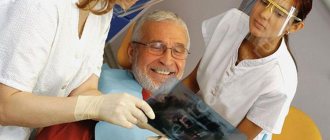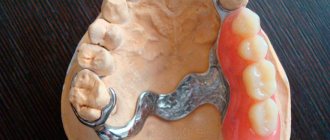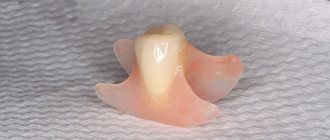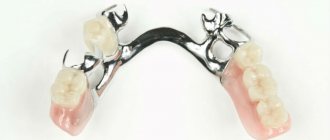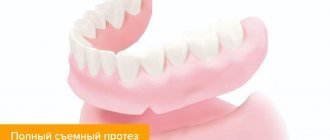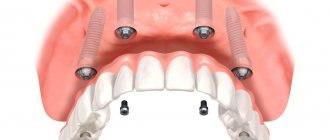Types of modern prostheses
By level of amputation:
- cosmetic finger prostheses;
- prosthetic part of the hand;
- full hand prosthesis;
- forearm prosthesis (up to the elbow);
- shoulder prosthesis;
- prosthesis after disarticulation of the shoulder joint.
According to the method of attachment to the limb stump:
- using a silicone case and lock;
- using the anatomical shape of the receiving sleeve;
- using belts (bandage).
According to their intended purpose, there are two groups of prostheses:
- cosmetic - imitate a natural hand, hiding the defect;
- functional - make it possible to use the injured limb.
According to the mechanism of action, functional prostheses are:
- bionic (myoelectric or bioelectric);
- workers (passive);
- traction (active mechanical).
Cosmetic dental prosthetics with veneers
Cosmetic dental prosthetics are usually performed using veneers.
Veneers are thin plates made of ceramic that are glued to the front teeth, covering them and creating the desired cosmetic effect. For example, with the help of just one veneer, which copies your enamel color and its unique features down to the smallest detail, you can correct one tooth that spoils the aesthetics of your smile - chipped, cracked or darkened due to caries and other problems. Or you can go further, deciding to make global changes, and install veneers on all teeth located in the “smile zone” - this is the part of the dentition that is most noticeable to others. You can choose the desired color and shape of your new smile - from natural options to the flawless sparkling whiteness that has become the calling card of most Hollywood stars.
By the way, almost all modern actors and actresses, shining with white-toothed smiles from the screens, were born with far from perfect teeth. Their appearance is the result of carefully thought-out and painstaking work of experienced orthopedic dentists in cosmetic dental prosthetics.
Bionic prostheses
The most advanced prostheses, as close as possible to the action of the human hand. To operate, they use an external energy source (rechargeable batteries), are equipped with electric motors and are controlled by electrical signals from the patient’s body. Myoelectric prostheses respond to muscle contraction. Changes in the electrical potential are detected by EMG sensors in the prosthetic socket. They transmit a signal to the microprocessor of the artificial hand, and the prosthesis performs a certain action.
Note!
- Conventional bioelectric prostheses make grip a breeze. This is the basic movement, but it is not always enough.
- Highly functional prosthetics can accommodate a variety of grips. For this, two myodensors are used that sense the activity of the two largest muscles of the arm. To select the desired gesture, the patient sends the prosthesis several sequentially repeated commands - they serve to switch modes by brute force. After training, the prosthesis becomes a real extension of the hand; the person uses it instinctively, performing different types of grips without thinking.
Bionic hand prostheses improve the quality of life of patients. People become able to perform complex activities such as drawing, working with a keyboard, tying shoelaces, cooking and many others. The latest generation of bionic prostheses are capable of performing finger movements. For example, the Touch Bionic hand from Ossur performs functionality close to the actions of a real hand, since each finger is equipped with a separate electric motor. The patient can choose from twelve hand grip options. Your prosthetic technician can help you determine your individual reaction speed and grip strength. This allows you to comfortably work even with very fragile objects, for example, taking a chicken egg.
Pros:
innovative technological appearance, use for all main types of household activities.
Minuses:
high cost, unnatural appearance.
Plate removable dentures
The most modern plate prostheses, in general, have not undergone significant changes during their existence. They are very conservative and are close relatives of the “grandmother” models. Only the materials have changed, new types of retaining clasps have appeared, etc. The plastic of the plate is now not just pink, but may even have a vascular network. Thanks to new technologies, the teeth made for these dentures have become more durable and hardly wear out over time. The appearance of artificial teeth has become much more attractive, which allows such dentures to be aesthetic and individual. Sometimes a situation arises where only a complete denture can replace lost teeth. The suction effect allows you to hold such a prosthesis in the mouth in the same way as two glasses moistened with water hold each other. The upper and lower jaws have significant anatomical differences; because of this, the prosthesis on the lower jaw is held much worse than on the upper jaw. It does not have a stable position, but remains mobile “floating”. Mini-implants can improve the fixation of such a prosthesis.
It is necessary to fight to preserve every tooth in the lower jaw and use every opportunity for this. Remember the rule - if there is at least one chance to save a tooth, you need to take advantage of it. It should be removed only for medical reasons when the tooth poses a danger to the patient’s health.
Working dentures
A working prosthesis is not at all like a regular hand. It is equipped with an adapter for installing various attachments, which allows you to actively use the upper limb for work. Attachments for writing, cutlery, drawing, printing, and sewing can be attached to the prosthesis. There are grips for hammers, keys, scissors and other tools.
Pros:
inexpensive design, great functionality.
Minuses:
unnatural appearance, the need to purchase attachments for each type of activity and change them during work.
Everything will be fine!
Clasp dentures are radically different from removable plate dentures. The only thing they have in common is that they can be taken off and put on. Bugel means “arc” in German. Instead of a massive plastic base covering almost the entire jaw, clasp dentures have a thin openwork casting, and support-retaining clasps very well fix the prosthesis both by specially prepared (clasp) crowns and simply by living teeth. Clasp dentures are comfortable and elegant, do not interfere with conversation, do not interfere with diction and do not affect the appearance of an undesirable accent. For clasp dentures, it is necessary to have several stable supporting teeth to which the clasps will cling. This allows you to get rid of the massive base, which is designed to perform supporting and suction functions. Teeth intended for support must be selected very carefully so as not to overload them during operation, otherwise the supporting-retaining apparatus may be damaged, and subsequently the teeth may become loose and fall out. Modern technologies and high-precision foundry production have made it possible to produce complex clasp structures in which hidden micro-locks (attachments) are installed - special fastening structures consisting of two jointly working elements. One element is located inside an artificial tooth or prosthesis base, the second is made with a crown or can be fixed in the preserved tooth root. Attachments vary in their design, the complexity of technical manufacturing and the materials from which the lock is made. All this affects the increase in the cost of technical execution and the rise in price of the prosthesis as a whole. Reliable fixation, ease of use, beautiful appearance and complete secrecy from others - these are the main advantages of modern clasp dentures.
Active mechanical prostheses
Active (or “traction”) - allow the artificial hand to compress, due to traction, to hold various objects. The action occurs using mechanical traction (when the opposite shoulder moves, the cable is tightened or loosened). A simple and reliable mechanism allows you to control the strength and speed of your grip.
With enough practice, a person masters fairly subtle movements: he can write with a pen, use cutlery, type, carry a bag, light matches.
Traction prostheses can be installed in children from 8 years of age. Constant training of the muscles of the shoulder and forearm subsequently helps to form a stump and quickly get used to a more advanced bionic prosthesis.
Pros:
simple mechanism, easy to maintain, precise movements when performing some delicate work.
Minuses:
the use of a traction band (can rub), the need to be careful with the prosthesis shell and periodically replace it.
UPPER LIMB PROSTHESES
The loss of one or both arms is difficult for the patient not only physically, but also psychologically. However, thanks to the use of modern prostheses, thousands of people lead full lives. With the help of lightweight, easy-to-use and functional orthopedic products, patients can not only perform familiar daily activities, but also complex, precise manipulations.
Depending on the degree of amputation, functionality and purpose, several types of prostheses are distinguished.
COSMETIC PROSTHETICS
Cosmetic prostheses are anatomical copies of the upper limbs that perform the aesthetic function of the amputated arm and serve to improve appearance.
They are made using safe materials that do not cause allergies - high-quality silicone, the color of which is matched to the patient’s skin color. Today you can choose prosthetics that are as close as possible to real hands with acrylic nails, hair, images of moles, veins and palm lines.
WORKING PROSTHETICS
Working prostheses have a special adapter instead of an artificial hand - it is attached to the prosthetic socket. Such products are equipped with many different working attachments that allow you to actively use the prosthesis in everyday life.
ACTIVE or TRACTION PROSTHETICS
Active, or as they are also called, traction prostheses allow the artificial hand to be compressed due to special cables and hold various objects. The mechanism of operation of such prostheses is based on a traction action - in order to compress or unclench the artificial hand, you need to make a special movement with your healthy shoulder.
PROSTHESES WITH AN EXTERNAL ENERGY SOURCE, or BIOELECTRIC
The most modern and functional prostheses of the upper limbs are bioelectric. They are made of polymer composite materials and equipped with an electronic brush made of light and durable metals. Such prostheses can be used for any level of amputation.
The principle of operation of bioelectric prostheses is based on the fact that after amputation, the stump of the hand retains groups of flexor and extensor muscles. Special sensors are located in the prosthetic sleeve - they are able to recognize bioelectric impulses in the preserved muscles. The resulting impulse, using an electronic amplification system, turns on a small but powerful electric motor that controls the fingers, raising or lowering the artificial hand.
With the help of a bioelectric prosthesis, the patient can perform many precise movements with an artificial hand.
Some of the bionic prostheses are controlled using an application that is installed on a smartphone or tablet.
PRODUCTION STEPS OF PROSTHETICS
The first step in the production of any type of prosthesis is the production of a prosthetic socket. To do this, the prosthetist technician makes a plaster cast, the so-called positive, based on individual measurements. Then the sleeve is made. After the socket is ready, prosthetists begin assembling the product according to the parameters recommended for the patient.
PROSTHETIC CARE
It is necessary to keep the product clean and remove dirt regularly. For some types of prostheses, sudden temperature changes are contraindicated. It is worth remembering that even minor mechanical damage can lead to serious damage.
HOW TO GET A PROSTHESIS?
By contacting the Territorial Centers for Social Protection of the Population at your place of residence, you can issue a referral for the manufacture of prosthetic and orthopedic products (and in the absence of contracts, issue a notice of further provision), as well as receive information and advice on existing government contracts with companies producing prosthetic devices -orthopedic products and the procedure for obtaining compensation in case of their independent purchase.
You can also contact the Moscow State Budgetary Institution “Resource Center for Disabled Persons” of the Department of Labor and Social Protection of the Population of Moscow by phone or at the address: Moscow, Novoostapovskaya Street, Building 6.
Cosmetic dentures
A cosmetic prosthesis is as close as possible to the natural appearance of a real hand, but is completely non-functional. You won’t be able to do anything complicated with it (for example, buttoning a jacket). The prosthesis consists of four parts: a stump, a supporting socket, a hand frame and a shell (glove). The shell is made of PVC or silicone, matching the patient's skin tone. For greater reliability, images of moles, veins, folds, and palm lines can be applied. It is possible to make a prosthesis with acrylic nails that are as close as possible to real ones.
Pros:
relatively low price, imitates a healthy hand, the hand looks natural - does not attract the attention of others.
Minuses:
the inability to perform any actions, the need to take care of the prosthesis shell and periodically replace it.
Restoration methods
Cosmetic restoration offers clients the following services:
— installation of lumineers and veneers;
— installation of crowns and pins;
- restoration of missing teeth.
There is a direct and indirect method of dental restoration. The direct method involves correcting deficiencies directly in the patient’s mouth. To do this, the dentist uses composite materials or special cement. During the procedure, 5 or 6 teeth are restored at once. This method helps to cope with malocclusion problems for a while, because after a certain period, teeth made of composite materials lose their attractiveness.
The indirect restoration method is much more complex and time-consuming than the direct one. Using this method, special plates are made from composite or porcelain and are used to hide all cosmetic defects of the teeth. To restore the appearance of teeth using the indirect method, several stages must be carried out. First, the doctor eliminates all inflammatory processes in the oral cavity, places fillings and cleans the canals.
Then he takes an impression of the teeth and makes veneers, and only then they are installed. By installing veneers, you can not only hide any defects, but also make your teeth snow-white. Contraindications to the indirect method of dental restoration are bruxism, malocclusion and the absence of one or more chewing teeth. Also, this method is not suitable for people who lead an active lifestyle and engage in extreme sports.
Simultaneously with orthodontic treatment, dental restoration can give an amazing effect at any age of the patient.
Installation of veneers
Installing veneers is a piecemeal and individual job, so the price of one veneer can be quite high. However, remember that on average there are only 10-16 teeth in the smile zone; installing veneers on all teeth is not only not necessary, but also pointless, since their function is purely aesthetic.
In addition, high-quality cosmetic dental prosthetics will delight you for many years in a row. Porcelain veneers do not darken or fade over time, especially if you take good care of your oral hygiene. Caries does not develop under them, since they reliably protect your teeth from external influences, and you do not need to remove the tooth pulp to install them.
However, it should be remembered that installing a veneer requires treatment of the front surface of the tooth. Is it harmful to grind down a tooth to install a veneer ? Provided that a ceramic veneer , this does not entail any negative consequences, but you will not be able to return the previous appearance of your teeth. Veneers are a decision that is made once and for a lifetime, so it should be taken carefully and thoughtfully. Our doctors, specialists in cosmetic dental prosthetics , are always ready to advise you and answer all your questions so that your choice is as informed and final as possible.
